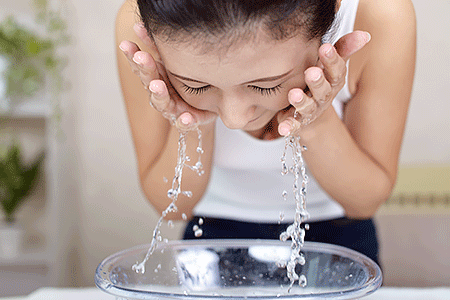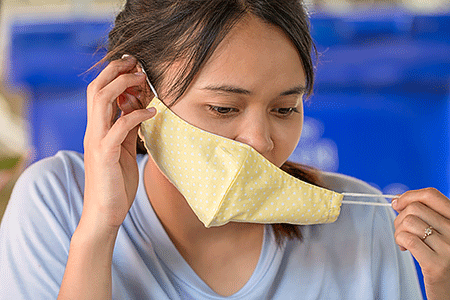9 ways to prevent face mask skin problems
Wearing a mask can be hard on your skin
Gentle skin care can prevent your mask from causing skin problems.

Masks play a vital role in reducing the spread of the coronavirus. Masks can also be hard on your skin, causing problems that range from acne and peeling skin to rashes and itchiness. To help prevent skin problems from developing under your mask, board-certified dermatologists recommend these nine tips.
Cleanse and moisturize your face daily. Gentle skin care can prevent skin problems. When washing your face, use a mild, fragrance-free cleanser and follow these steps, Face washing 101.
Protect your lips by applying petroleum jelly. Dry skin and chapped lips are common face mask skin problems. You can prevent chapped lips by applying petroleum jelly to your lips:
- Before you put on your mask
Skip the makeup when wearing a mask. Beneath a mask, makeup is more likely to clog your pores and lead to breakouts. If makeup is necessary, use only products labeled “non-comedogenic” or “won't clog pores.”
Avoid trying new skin care products that can irritate your skin. Wearing a mask for even a short time can make your skin more sensitive. To reduce skin problems, avoid trying harsh products, such as a chemical peel, exfoliant, or retinoid, for the first time, says board-certified dermatologist Daniela Kroshinsky, MD, MPH, FAAD.
Retinoids can irritate your skin
“If you’ve been using a retinoid (or retinol), apply it at bedtime and don’t increase the amount that you apply.”
Tip courtesy of board-certified dermatologist Daniela Kroshinsky, MD, MPH, FAAD

Use less of certain skin care products if your face becomes irritated. When you cover your face with a mask, some skin care products that you’ve used in the past may irritate your skin. If this happens, Dr. Kroshinsky recommends cutting back on products that can irritate your skin, such as:
Wear the right mask. To reduce skin problems, look for masks that offer the following:
- At least two layers of fabric
Take a 15-minute mask break every 4 hours. Health care workers on the frontlines of the coronavirus pandemic have found that this helps save their skin. Of course, only remove your mask when it’s safe to do so and after washing your hands.
Wash your cloth masks. Many health care organizations now recommend that you wash a cloth mask after each use. Washing it also removes oils and skin cells that collect inside the mask, which could lead to a skin problem.
Continue the treatment plan that your dermatologist created for you. If you have a skin condition, such as acne or rosacea, it’s especially important to follow your treatment plan. This can help keep the condition under control.
You can prevent breakouts from your moisturizer by using a moisturizer formulated for your skin type. When selecting moisturizer, follow this guide:
Normal or combination skin: Lotion
Dry to very dry skin: Cream
If you have acne or tend to break out, you can still use a gel moisturizer.
Apply moisturizer before and after wearing a mask
Moisturizer can prevent problems, especially if you have dry or sensitive skin.
Tip courtesy of board-certified dermatologist Carrie L. Kovarik, MD, FAAD

To prevent breakouts, take care to apply the petroleum jelly only to your lips.
Use masks to slow the spread of COVID-19
To see who the Centers for Disease Control and Prevention (CDC) says should wear a face mask, go to: Use masks to slow the spread of COVID-19
Wearing a mask that offers a snug, but comfortable fit helps to protect you and others from the coronavirus. You want a snug fit across your nose, on the sides, and under your chin.
For more tips on selecting a face mask to prevent the spread of COVID-19, visit the Centers for Disease Control and Prevention at CDC.gov/coronavirus.
How to choose the right face mask for your skin
Choosing the right face mask can help prevent skin problems. Board-certified dermatologists recommend looking for these things when choosing a face mask.
Stop behind-the-ear soreness
Find masks with different types of ties and ear loops and wear a different type each day.
Tip courtesy of board-certified dermatologist Daniela Kroshinsky, MD, MPH, FAAD

After washing your mask, check its shape. If a mask no longer fits snugly (and comfortably), it is less protective.
If you develop a face mask skin problem
Life gets busy. Sometimes, it’s hard to care for your skin as planned. If a skin problem develops under your mask, you may be able to treat it yourself. See what dermatologists recommend at, Face mask skin problems: DIY treatment.
Related AAD resources
Images
All content solely developed by the American Academy of Dermatology
Supported by:
 Think sun protection during Skin Cancer Awareness Month
Think sun protection during Skin Cancer Awareness Month
 How to care for your skin if you have lupus
How to care for your skin if you have lupus
 Practice Safe Sun
Practice Safe Sun
 Sunscreen FAQs
Sunscreen FAQs
 Fade dark spots
Fade dark spots
 Hidradenitis suppurativa
Hidradenitis suppurativa
 Laser hair removal
Laser hair removal
 Scar treatment
Scar treatment
 Botox
Botox
 Kids' camp - Camp Discovery
Kids' camp - Camp Discovery
 Dermatologist-approved lesson plans, activities you can use
Dermatologist-approved lesson plans, activities you can use
 Find a Dermatologist
Find a Dermatologist
 Why choose a board-certified dermatologist?
Why choose a board-certified dermatologist?
